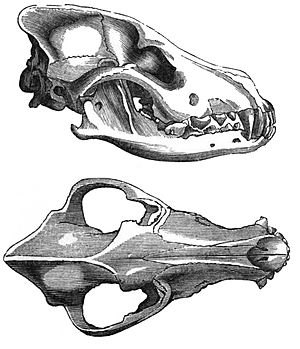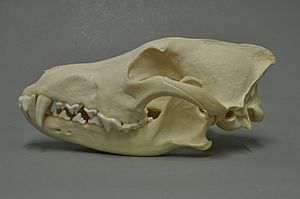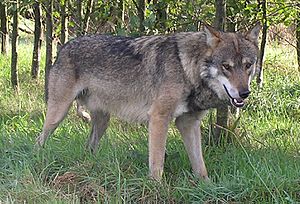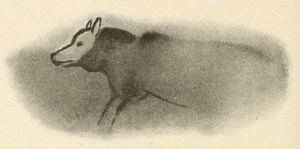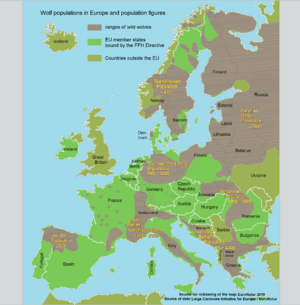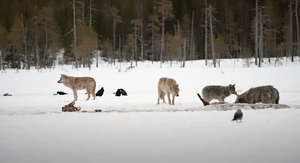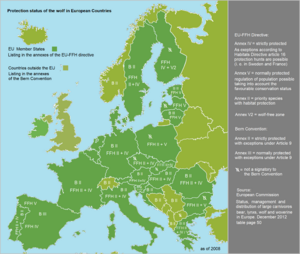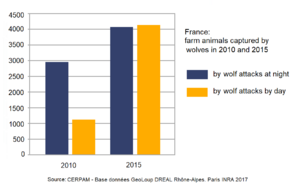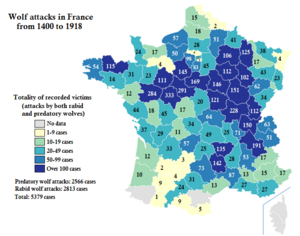Eurasian wolf facts for kids
The Eurasian wolf (Canis lupus lupus), also known as the common wolf, is a type of grey wolf found in Europe and Asia. Long ago, before the Middle Ages, these wolves lived all over Eurasia. People often talked about wolves in their stories and languages, showing how important these animals were to their cultures. Many ancient groups, like the Celts, Slavs, and Greeks, respected the wolf.
Quick facts for kids Eurasian wolf |
|
|---|---|
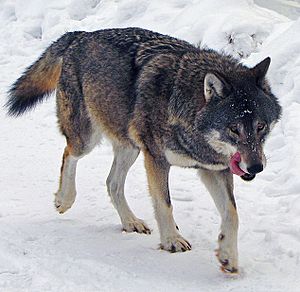 |
|
| Eurasian wolf in the Kolmården Wildlife Park, Sweden | |
| Conservation status | |
| Scientific classification |
|
| Kingdom: | Animalia |
| Phylum: | Chordata |
| Class: | Mammalia |
| Order: | Carnivora |
| Family: | Canidae |
| Genus: | Canis |
| Species: | |
| Subspecies: |
C. l. lupus
|
| Trinomial name | |
| Canis lupus lupus (Linnaeus, 1758)
|
|
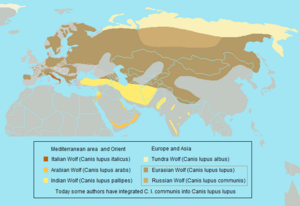 |
|
| C. l. lupus range | |
| Synonyms | |
|
List
altaicus (Noack, 1911)
argunensis (Dybowski, 1922) canus (Sélys Longchamps, 1839) communis (Dwigubski, 1804) deitanus (Cabrera, 1907) desertorum (Bogdanov, 1882) flavus (Kerr, 1792) fulvus (Sélys Longchamps, 1839) italicus (Altobello, 1921) kurjak (Bolkay, 1925) lycaon (Trouessart, 1910) major (Ogérien, 1863) minor (Ogerien, 1863) niger (Hermann, 1804) orientalis (Wagner, 1841) orientalis (Dybowski, 1922) signatus (Cabrera, 1907) |
|
Eurasian wolves are the biggest grey wolves in the Old World (Europe, Asia, and Africa). In Europe, they usually weigh about 39 kilograms (86 pounds). Some very large wolves have weighed up to 79 kg (174 lb)! Their fur is short and rough, often a yellowish-brown color. They have white fur on their throats. It's rare to see black, white, or reddish Eurasian wolves, and these colors often happen when wolves mix with dogs.
The howl of a Eurasian wolf sounds more drawn out and musical than the howls of North American grey wolves. However, wolves from both places can understand each other's howls.
Many Eurasian wolf groups have to eat livestock (farm animals) and even garbage in areas where many people live. But in places like Russia and the mountains of Eastern Europe, their main food sources are still wild animals. These include large hoofed animals like moose, red deer, roe deer, and wild boar. They also hunt reindeer, argali, mouflon, wisent, saiga, ibex, chamois, wild goats, fallow deer, and musk deer.
Contents
Physical Features

Body Shape
When comparing North American wolves to European wolves, scientists have noted some differences. European wolves tend to have a narrower head that smoothly tapers to the nose. Their ears are taller and closer together. Their bodies are more slender, with longer legs and narrower feet. Their tails also have less fur.
Size and Weight
The size of Eurasian wolves changes depending on where they live. Wolves in Russia and Scandinavia are usually bigger than those in Western Europe. They can be compared to the large wolves found in places like Montana in the United States.
Adult wolves in Russia are typically 105 to 160 centimeters (41 to 63 inches) long. They stand about 80 to 85 cm (31 to 33 in) tall at the shoulder. Their average weight is 32 to 50 kg (71 to 110 lb). The heaviest wolf ever recorded in Ukraine weighed 86 kg (190 lb). Wolves in Sweden and Norway are often heavier built, even if they are similar in length to Russian wolves. An Italian wolf usually measures 110 to 148 cm (43 to 58 in) long (not including the tail). Males weigh between 25 and 35 kg (55 and 77 lb).
Where Wolves Live
Past Decline
In Northern Europe, people started organized efforts to get rid of wolves during the Middle Ages. This continued until the late 1800s. In England, laws were made to hunt wolves, and the last one was killed in the early 1500s. Wolves lasted longer in Scotland, hiding in large forests.
By 1960, very few wolves were left in Sweden. The last one was killed in 1966. Wolves were gone from Denmark by 1772 and Norway by 1973. In Finland, their numbers dropped a lot in the 20th century, even though wolves sometimes came from Russia.
In Central Europe, wolf numbers also fell sharply in the early 1800s. This was due to organized hunts and fewer wild animals for them to eat. In Germany, the last free-living wolf before 1945 was shot in 1904. Today, wolves have returned to Germany.
In France, wolf hunting was officially started by Charlemagne around 800 AD. This created special wolf hunters. In 1883, many wolves were killed, often with poison.
In Eastern Europe, wolves were never completely wiped out. This is because the area has large forests and connects to Asia. However, their numbers became very low by the late 1800s. Wolves disappeared from Slovakia in the early 1900s. By the mid-1900s, they were only found in a few forests in eastern Poland.
In the Soviet Union, wolves lived almost everywhere. But their numbers dropped greatly after both World Wars. By 1970, wolves had disappeared from much of European Russia.
As of 2017, the grey wolf was considered gone from eight European countries: Austria, Belgium, Denmark, Ireland, Luxembourg, Netherlands, Switzerland, and the United Kingdom. However, since then, wolves have returned and settled in most of these countries, except for the islands of Ireland and Great Britain.
Current Recovery
European wolf populations started to recover after the 1950s. This happened because fewer people lived in rural areas, and there was less need to hunt wolves. Also, the number of wild animals for wolves to eat increased.
In 1978, wolves began to return to central Sweden after being gone for 12 years. They have since spread into southern Norway. By 2005, there were at least 100 wolves in Sweden and Norway. The grey wolf is fully protected in Sweden. The wolves in Scandinavia exist because of the large wolf population in Finland, which connects to Russia. Wolves in Finland are protected and can only be hunted with special permission.
Wolf populations in Poland have grown to about 800–900 animals. They have been legally protected for over two decades. Scientists found that by 2019, there were at least 95 wolf packs living west of the Vistula River in Poland. Some of these wolves have moved into eastern Germany. In 2000, the first wolf pups were born in Germany in a long time. By 2021, about 1400 wolves were estimated to be living in Germany.
As of June 2021, the grey wolf is protected in Slovakia. Some Slovak wolves travel into the Czech Republic, where they are also fully protected. Romania has a large wolf population of about 2500 animals. The wolf has been protected in Romania since 1996.
Wolf populations in Northern and Central Asia are not fully known, but there are likely hundreds of thousands of them. After the fall of the Soviet Union, wolf hunting stopped in many areas. This caused wolf numbers to increase by about 150% in the former Soviet Union, reaching 25,000–30,000 animals.
Legal Protection
The Eurasian wolf and the Italian wolf are legally protected in most European countries. This protection comes from international agreements like the EU Habitats Directive or the Berne Convention on the Conservation of European Wildlife and Natural Habitats. These laws help keep wolf populations safe.
Conflicts with Humans
Attacks on Farm Animals
In Switzerland in 2021, there were 853 wolf attacks on farm animals. This happened even though there were about 200 livestock guardian dogs protecting the herds. In Germany, between 2000 and 2019, wolf attacks on grazing animals increased greatly. The number of injured and killed animals reached 2900 in one year. This shows that wolves sometimes specialize in hunting farm animals.
In France, the number of animals killed in unprotected herds went down between 2010 and 2015. This was because more herds were being protected. However, the number of animals killed in *protected* herds went up. Wolves also started attacking more often during the day. In 2018, about 12,500 farm animals were lost to wolf attacks in the French Alps. This was with about 500 wolves and thousands of guardian dogs in the area. Sometimes, even the livestock guardian dogs themselves became victims of wolves.
Attacks on People
Historically, there have been reports of wolves attacking people. For example, in Estonia, between 1804 and 1853, 111 people were reported killed by wolves. Most of these were children. In France, historical records show that nearly 7,600 people were killed by wolves between 1362 and 1918. Many of these attacks were by wolves that were not sick with rabies.
However, it's important to know that wolves that have recently returned to Central Europe usually come from areas with plenty of wild game and farm animals. This means they are not typically interested in children as prey. In modern times, wolf attacks on humans are extremely rare, especially from healthy wolves. Most reported attacks in the past involved wolves with rabies or those that were desperate for food during times of war or famine.
After World War II, Soviet scientists investigated wolf attacks. They found that attacks had increased during the war. A report in 1947 described many attacks, including some by seemingly healthy wolves. However, the Soviet authorities kept this information from the public.
Wolves and People
Myths and Stories
Wolves have been important in many ancient stories and beliefs across Eurasia. In Hittite mythology, wolves were often seen as powerful figures. Many Indo-European cultures saw wolves as gods or important symbols. The Dacians, an ancient people, even got their name from a word meaning "wolf people." They believed the wolf was the lord of all animals and a strong force against evil. The ancient Greeks also linked wolves to their sun god, Apollo.
Not all stories were positive. In Norse mythology, the giant wolf Fenrir is said to kill the god Odin during the end of the world. Still, Germanic warriors admired wolves for their fierceness. They often used the wolf as their symbol. In Lithuanian mythology, an iron wolf told Grand Duke Gediminas to build the city of Vilnius. The Tengrism religion also highly respects the wolf, believing that when a wolf howls, it is praying to their god, Tengri. This makes the wolf one of the few creatures, besides humans, that worships a deity.
See also
 In Spanish: Lobo europeo para niños
In Spanish: Lobo europeo para niños



